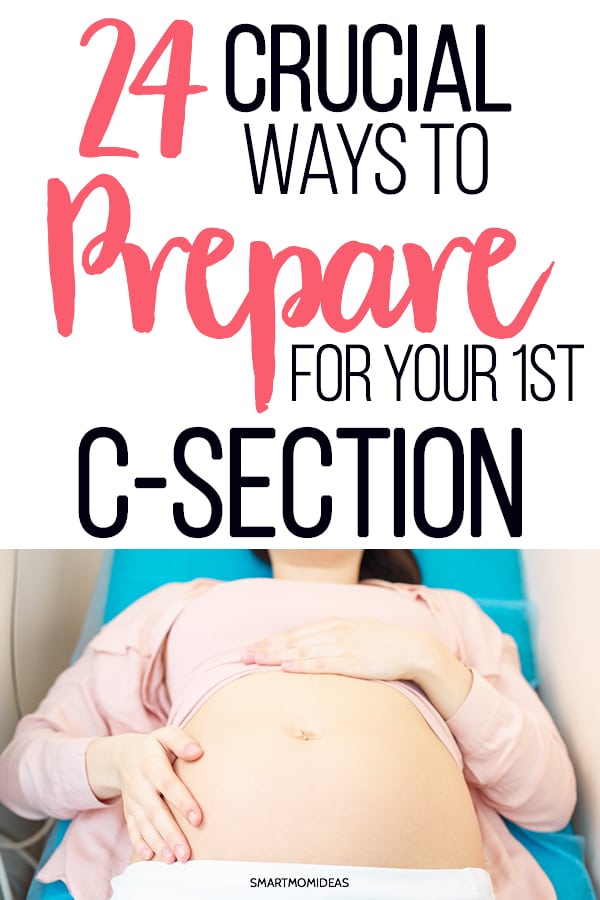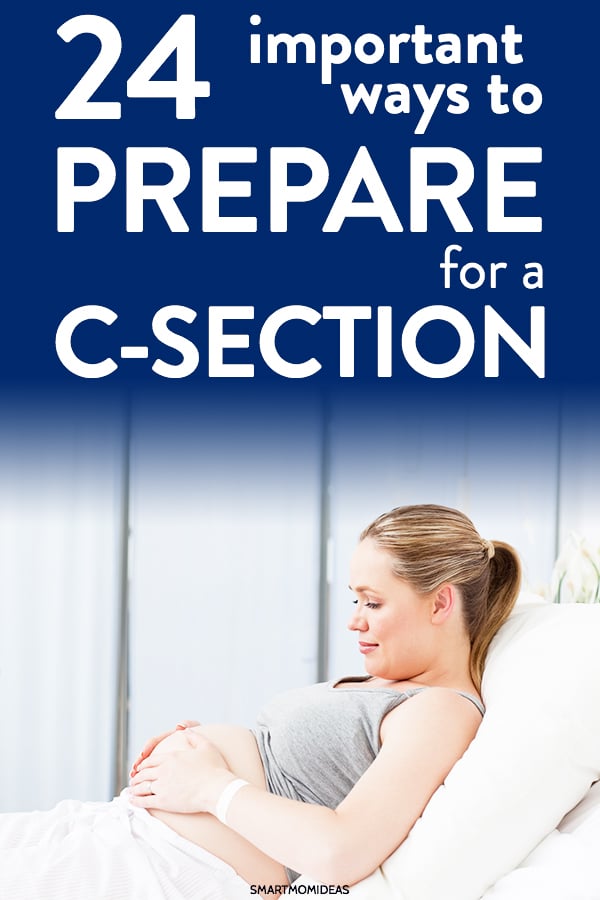How to prepare for a c-section procedure if this is your first time!

The time is near.
Giving birth is on the horizon, but there’s a snag – instead of the vaginal delivery you were expecting, your doctor tells you to have a c-section.
For some moms, this is a surprise, and for other’s it’s not. I was hoping to deliver my twins vaginally, but I developed Intrauterine Growth Restriction.
Plus, my cervix started to open at around 23 weeks pregnant. Fortunately, I gave birth to two healthy twins!
I wanted to share how you can prepare for a c-section procedure if this is your first time. Knowing will help ease any anxiety you may have!
What is a C-section?
A C-section, or cesarean section, is when a baby is delivered via a surgical incision made in the lower abdomen. It is performed in an operating room and a sheet separates your view from the procedure.
Before the surgery, you are given a catheter (to drain urine from your bladder) and an IV line (to keep you hydrated). You have the option of different types of anesthesia: regional or general.
Regional anesthesia is administered to the lower body, meaning that the lower portion of your body will be numb but you will remain awake for the procedure. Common forms of regional anesthesia for a C-section include an epidural or a spinal block.
The other option is general anesthesia, which renders you completely unconscious, meaning that you will not be able to see, feel or hearing anything during the procedure.
Once you are anesthetized, a small incision is made through the abdomen into the uterus and the baby is lifted out. The incision in usually horizontal but can be vertical. After everything is said and done, you are closed up with dissolving stitches on the inside and stitches or staples on the outside.
Afterward, the catheter is removed, the IV is taken out after you are eating and drinking and you have a sweet little of bundle of joy.
Reasons for Having a C-section
- sections are performed when the mother and/or the baby is in distress or there is risk in having a vaginal birth. You may have a C-section if you are experiencing a slow or difficult delivery, if your cervix is not dilating or if you have had previous C-sections.
After already having a C-Section, it is possible to have a vaginal birth. However, your doctor will help to determine any risks involved and help guide you to the best choice for your baby.
Issues inside your uterus can determine whether or not a C-section is necessary. There are a few rare, but possible, conditions that could hinder a vaginal birth:
- Plancental Previa: This extremely rare occurrence (which happens in only 0.005% of pregnant women) is characterized by the placenta partially or completely blocking the cervix.
- Placental Abruption: This is when the placenta separates from the uterine liner during the 3rd It only happens to 1% of pregnant women.
- Breech Position: When a baby is in breech position, it means that they are not heading down the birth canal headfirst and instead posed bum or feet first. Vaginal birth is possible but may be risky and painful.
- Cord Prolapse: Another extremely rare situation, cord prolapse occurs when the umbilical cord protrudes from the vagina before the baby.
More common causes for a C-section include fetal distress, in which the baby is not receiving enough oxygen through the placenta. This could be caused by preeclampsia, which is when the mother experiences high blood pressure.
This rise in blood pressure means that not enough blood is flowing to the placenta, so the placenta is not creating enough oxygen for the baby.
Lastly, if you are expecting multiplies (twins, triplets, quadruplets, etc.) – like me – then it’s expected to have a C-section birth. While it may be possible to birth multiples vaginally, the number of babies, their size and their positions will help to determine if this is possible.
Preparing for a C-Section
The thing about C-sections is that you may not even know you need one until you are trying to deliver your baby.
Depending on the reason why a C-section is necessary, you may know about it ahead of time, close to delivery time or during delivery (known as an emergency cesarean section).
However, there are some simple things you can do to prepare for a C-section – and some of them you can do even if you don’t expect to have one.
Have a Birth Plan
- Determine who is going to be with you.
- Ask if you can have the epidural or spinal block before the catheter goes in to reduce discomfort.
- Decide if you want the screen between you and your lower half up or down. (I.e., Do you want to watch your baby being born?)
- Make a skin-to-skin plan. If you can’t hold your baby to your skin right away, can your partner?
The Night and Morning Before
- Be sure not to have any foods or liquids after midnight.
- Get a good night’s sleep.
- Try to empty your bowels so that your first bowel movement post-procedure is easier.
- Wax or shave your bikini area. This is not for any aesthetic reasons – it simply eliminates the need for a nurse to do it with a disposable razor.
- Brush your teeth in the morning.
- Have a shower.
- Have your hospital bag packed and ready to put in the car.
Pack Your Hospital Bag
- Pack all the regular things you should bring to the hospital.
- Bring some cotton, high-waist pants that fit over where the incision area will be.
- Include a dressing gown and nightgown – something loose fitting that won’t put pressure on the incision area.
- Have some peppermint tea on hand to help alleviate trapped gases.
- Bring some entertainment – you may not go in right at your scheduled time.
- Pack items that do not require water that you can use in bed such as wipes and mouthwash. This reduces the need to call on the nurse to help you to the bathroom.
Related reading: The Essential Hospital Bag Checklist for Pregnant Moms
Get Ready to Recover
- Organize help from family and friends to make meals, get groceries and do light housework.
- Also delegate the care of other children and pets.
- Prepare some freezer meals ahead of time.
- Establish a recovery station – keep essential items (such as diapers, water, painkillers, etc.) near your bed or sofa.
- Take some stool softeners to help with that first poop.
- Buy some recommended creams and lotions to help with itchiness around the incision area.
- Keep a pillow on hand to hold against your abdomen in case you laugh, cough or have a bowel movement.
Recovering from a C-Section
It is recommended that you do not do any heavy work or lifting for 6 weeks following your C-section procedure.
However, you can slowly begin adding in regular everyday activities as soon as the pain begins to subside. Just be sure to move within your limits and not over-extend your body.
However, you should try to move around as soon as possible following your surgery, even if this means a slow trip to the bathroom.
The longer you lay around in bed with no movement, the higher the risk that your veins become stagnant and cause blood clots.
Keep taking painkillers at your doctor’s recommendation.
You’ll be able to move around with more ease if you experience less pain. Keep in mind that the combination of painkillers and the heightened hormone levels in your body may lead to constipation.
If you do experience constipation, up your intake of fiber and water or consider taking a stool softener until things get moving again. You should also be focusing on eating whole and nutritious foods, especially those high in vitamin C. Healthy foods will help your body to heal.
When it comes to C-section recovery, do as much ahead of time as you can so that you can focus on resting and not overusing your body. Focus on healing your body and caring for your little one.
It was difficult for me to adjust because I had to constantly care for my twins, but at that time, we were living in a 1-bedroom apartment so there wasn’t a lot of space to move!
I hope this guide helped you prepare for your c-section procedure!
Please remember to pin me!






Leave a Reply